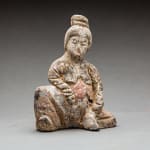Group of nine Tang period female entertainers, 618 CE - 906 CE
Terracotta
16.5 x 11.4 cm
6 1/2 x 4 1/2 in
6 1/2 x 4 1/2 in
TF.036
Further images
-
(View a larger image of thumbnail 1
)

-
(View a larger image of thumbnail 2
)

-
(View a larger image of thumbnail 3
)

-
(View a larger image of thumbnail 4
)

-
(View a larger image of thumbnail 5
)

-
(View a larger image of thumbnail 6
)

-
(View a larger image of thumbnail 7
)

-
(View a larger image of thumbnail 8
)

-
(View a larger image of thumbnail 9
)

-
(View a larger image of thumbnail 10
)

-
(View a larger image of thumbnail 11
)

-
(View a larger image of thumbnail 12
)

After almost 300 years of division and fragmentation following the collapse of the Han dynasty in 220 A.D., China was once again unified under the Sui dynasty (581–618). The numerous...
After almost 300 years of division and fragmentation following the collapse of the Han dynasty in 220 A.D., China was once again unified under the Sui dynasty (581–618). The numerous political and governmental institutions established during this brief period of peace and affluence lay the foundations for the growth and prosperity of the succeeding Tang dynasty.
Marked by strong and benevolent rule, successful diplomatic relationships, economic expansion and a cultural efflorescence of a very cosmopolitan style, Tang China emerged as one of the greatest empires in the medieval world and became one of the most magnificent periods in China's feudal history.
Merchants, clerics, and envoys from India, Persia, Arabia, Syria, Korea and Japan thronged the streets of Chang’an, the then capital, and hearing foreign languages spoken was a common part of daily life. Artists paid close attention to the richly colorful society, and were especially interested in displaying the idle and carefree life of aristocratic women and men. Although the Tang Dynasty was superior to the Han Dynasty in terms of ruling people's lives and all laws were more or less designed to facilitate to the needs of the nobility, there still were a great number of stipulations as to restricting and conform civilians' daily life. During the Tang Dynasty, court officials were allowed to openly indulge in dallying with courtesans though the fate of both state-owned prostitutes and prostitutes catering for the army was extremely unfortunate. According to the law and in certain circumstances, army commanding officers could actually put to death an army prostitute and not been punished. Burial figurines of graceful dancers and musicians, mythical beasts and everyday objects in terracotta reveal not only how people in early China approached death but also how they lived. Since people viewed the afterlife as an extension of worldly life, such terracotta figurines, called mingqi or “spirit utensils,” disclose details of routine existence and provide insights into their belief system.
Marked by strong and benevolent rule, successful diplomatic relationships, economic expansion and a cultural efflorescence of a very cosmopolitan style, Tang China emerged as one of the greatest empires in the medieval world and became one of the most magnificent periods in China's feudal history.
Merchants, clerics, and envoys from India, Persia, Arabia, Syria, Korea and Japan thronged the streets of Chang’an, the then capital, and hearing foreign languages spoken was a common part of daily life. Artists paid close attention to the richly colorful society, and were especially interested in displaying the idle and carefree life of aristocratic women and men. Although the Tang Dynasty was superior to the Han Dynasty in terms of ruling people's lives and all laws were more or less designed to facilitate to the needs of the nobility, there still were a great number of stipulations as to restricting and conform civilians' daily life. During the Tang Dynasty, court officials were allowed to openly indulge in dallying with courtesans though the fate of both state-owned prostitutes and prostitutes catering for the army was extremely unfortunate. According to the law and in certain circumstances, army commanding officers could actually put to death an army prostitute and not been punished. Burial figurines of graceful dancers and musicians, mythical beasts and everyday objects in terracotta reveal not only how people in early China approached death but also how they lived. Since people viewed the afterlife as an extension of worldly life, such terracotta figurines, called mingqi or “spirit utensils,” disclose details of routine existence and provide insights into their belief system.











